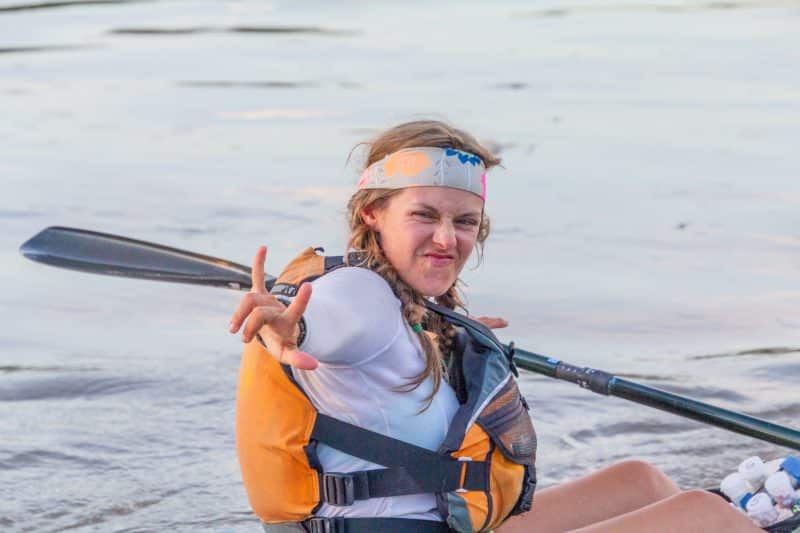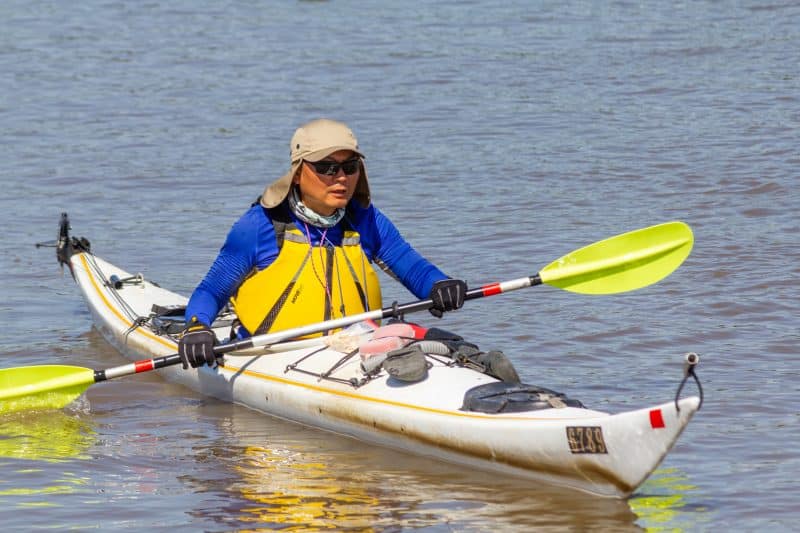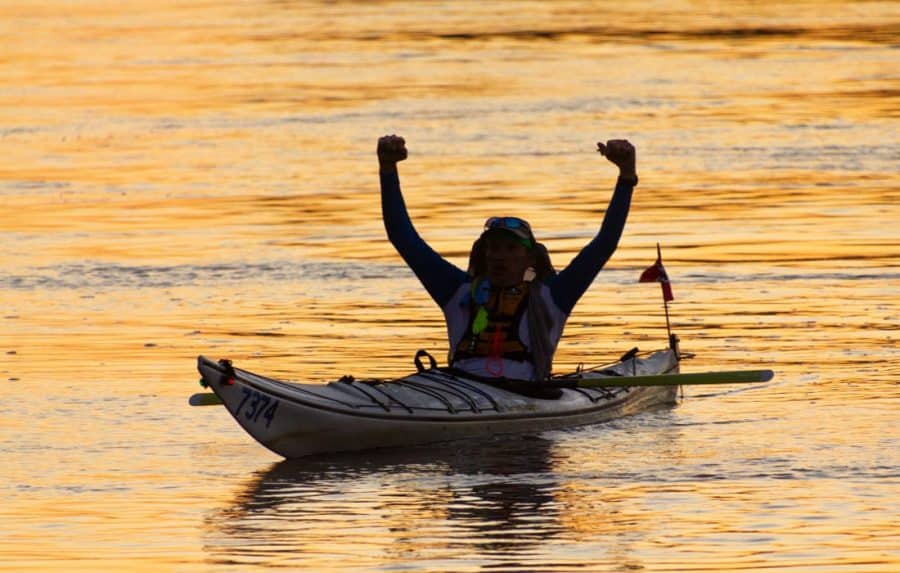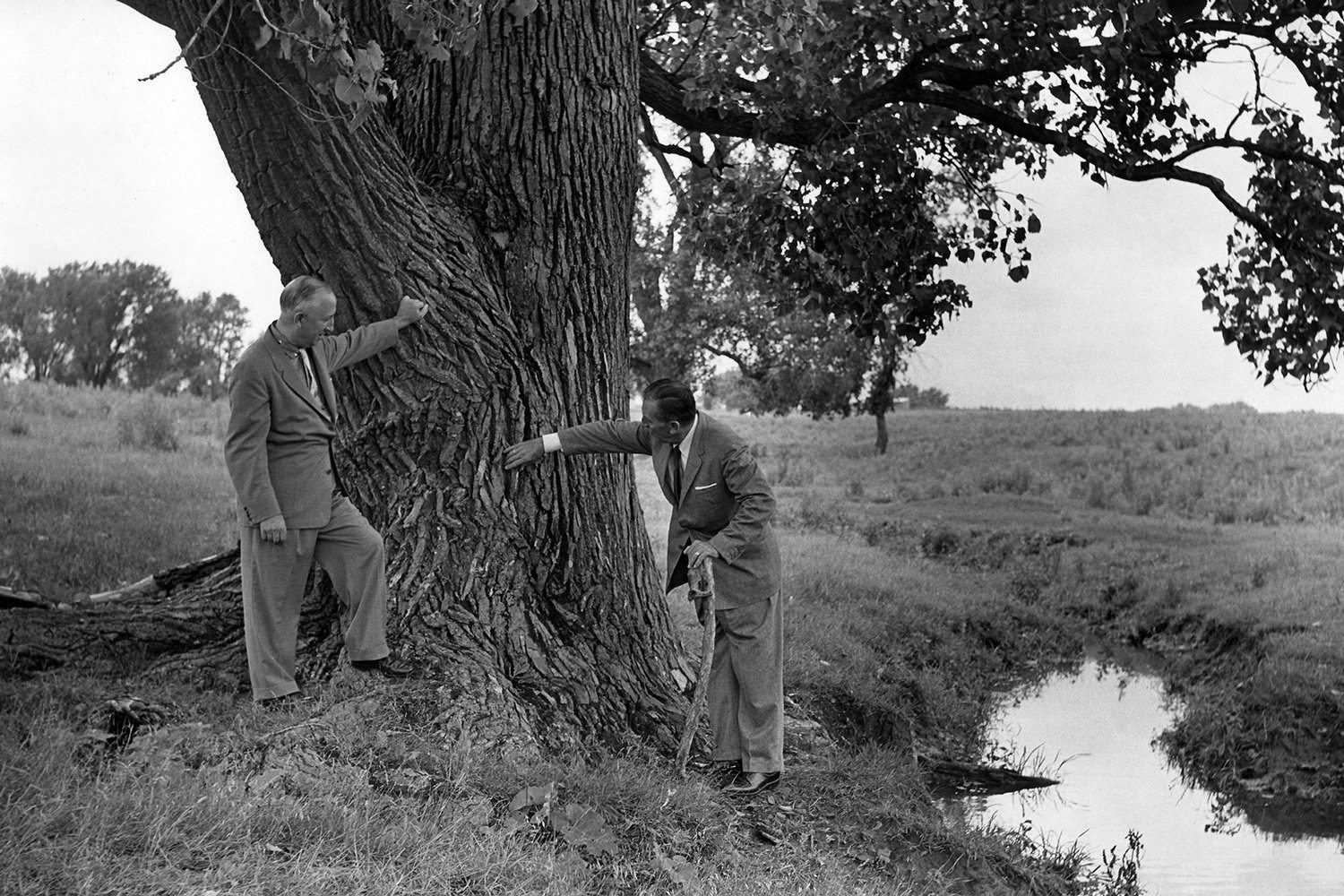Hundreds of kayaks and canoes crowd the boat ramps waiting for their turn to slide into the confluence of the Kansas and Missouri Rivers. Meriwether Lewis and William Clark once stood here at Kaw Point on their legendary trip, one of the last stops in known territory before plunging into the unknown. Although Kansas City skyscrapers now crowd the horizon, the hundreds of people setting off from this point are beginning their journey with the same adventurous spirit as the Corps of Discovery did in 1804.
Stretching from Kansas City to St. Charles, the annual MR340 (Missouri River 340 miles) is the country’s longest continuous river race and definitely not a normal float trip. Participants are allowed 88 hours to finish the race; behind them, the dreaded Reaper boat follows. The Reaper marks the slowest pace allowed, and if it passes racers, they are disqualified. To be competitive, paddlers must endure 340 miles of heat, wind, bugs, and rain, forgoing sleep and ignoring fatigue to finish the race in less than 40 hours. In this event, there is no rest for the weary.
So what’s in it for competitors in a race where just finishing is an achievement? The racers have their reasons. Some consider this a form of extreme vacationing, a chance to reach a personal best, or the opportunity to prove something. Still others are fighting to be the best and win a trophy. One thing is for sure in a race that now draws contestants from around the world: the community that built up around it is getting stronger and so is the competition.
Not everyone will finish the MR340, but those who paddle the course will make memories of a lifetime and learn something about themselves along the way. Just ask these competitors from the 2018 race.
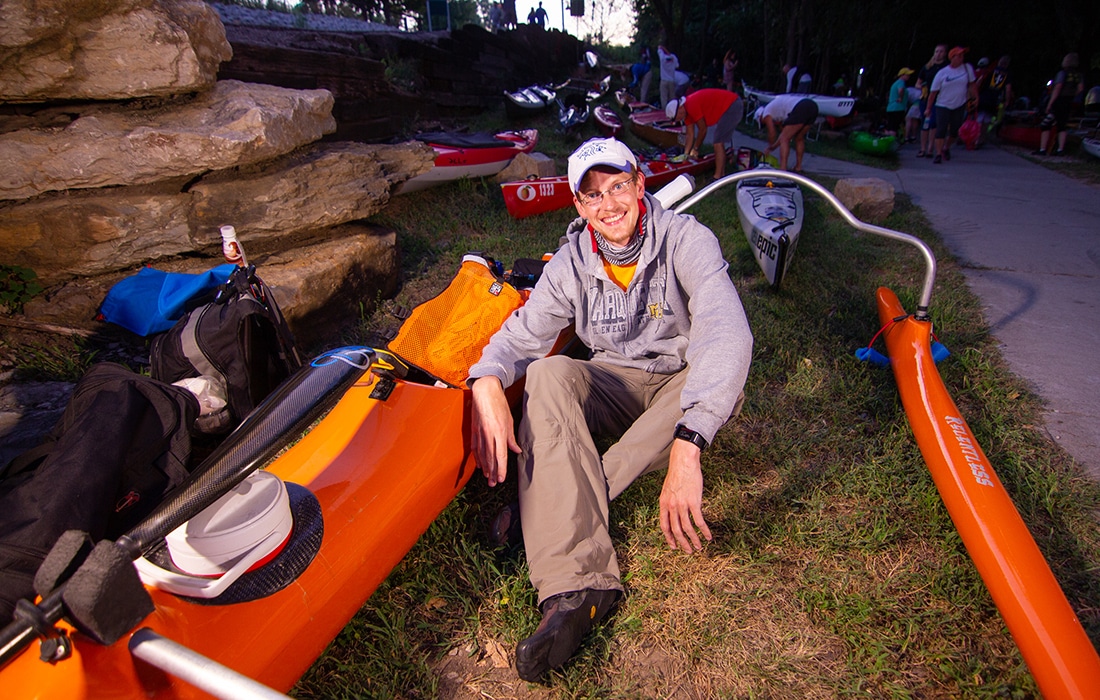
Motives
What brought you here? Why would you undertake this grueling race?
Mandy Urban:
There is so much symbolism that I get from being on the river. Finding a race like the MR340, where I can push myself, challenge my challenges, and go with the flow are a few reasons why I love racing on the river. I also love the people. River people are the best people! I have a family of racers and supporters that are unlike any other group of people. They see you at your best and your worst and still paddle by your side.
Christopher Luedke:
I live in Wisconsin and have competed in seven MR340 races. I like the community surrounding the race; that is what makes me come back year after year. There is a difficult-to-explain camaraderie on the water. There are few secrets, and any question is answered. These are the kind of people who will give you the shirt off their back if you asked. I also run a YouTube channel devoted to the race called 340Paddler where I talk about tips and tricks and give advice. It’s a good resource for people just getting into it.
Anqi Dai:
I came to the US in 1988 with five bucks in my pocket and one suitcase to attend college in Kansas. It was a challenge, but I have achieved the American Dream! I used that same determination to finish the MR340 in 2017 and 2018. I wanted to test my strength and ability. I wanted to prove to myself that I could complete the race at the age of 54. Finishing the race gives me a sense of accomplishment and shows my children that determination will help you achieve a lot.
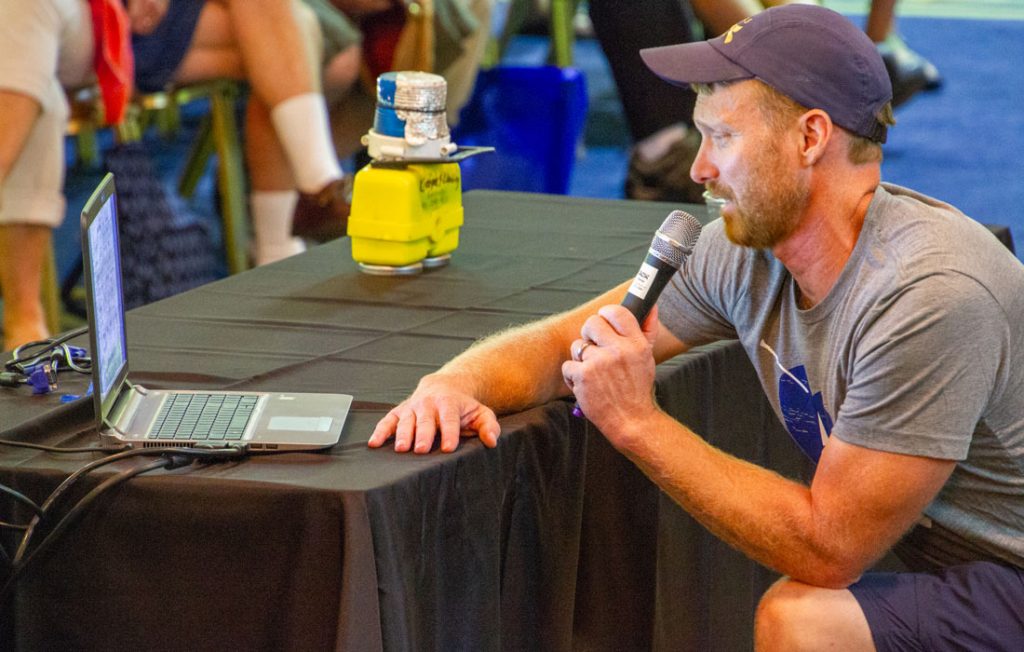
Diane McHenry:
I grew up in a small Missouri River town and my husband, Chuck, and I are kind of addicted to river racing. I’m the only person who’s been in every MR340—13 so far—since the beginning when there were less than 20 racers. At 62, I was also one of the oldest racers competing in 2018. I’ve done four mixed tandems in the past, and 2018 was my fourth year in women’s tandem, second with my teammate and friend, Mandy. In the women’s tandem category, I’m on four teams in the top 10. Two of those are with Mandy, so we’re a good team. In 2017, I finished in second place in women’s solo.
Bob Hines:
The people are by far the best part of this race. The first day of the race is so amazing. Everybody is so close together that I like to paddle up to them and just start talking for a bit: “Where you from? Is this your first time? I see you have an Iowa sticker on your boat. What part? Yeah, I raced in 2016 as well, it was hot as hell.” I’m still friends with some of those from my first race in 2013 and I keep adding more every year.
Cecelia Hines:
I want to remember everything because in the end I want to be able to look back and know it was all worth it.
Close Calls
Huge barges, heat exhaustion, and fatigue are only some of the dangers. What were yours?
Anqi Dai:
One night at my first MR340 in 2017, around midnight, I was exhausted after 16 to 17 hours of paddling that day. I was headed toward a wing dike when someone to my left suddenly yelled for me to watch out. I immediately “woke up” and made a quick left turn to steer away from the dike. It was too close for comfort for sure.
Diane McHenry:
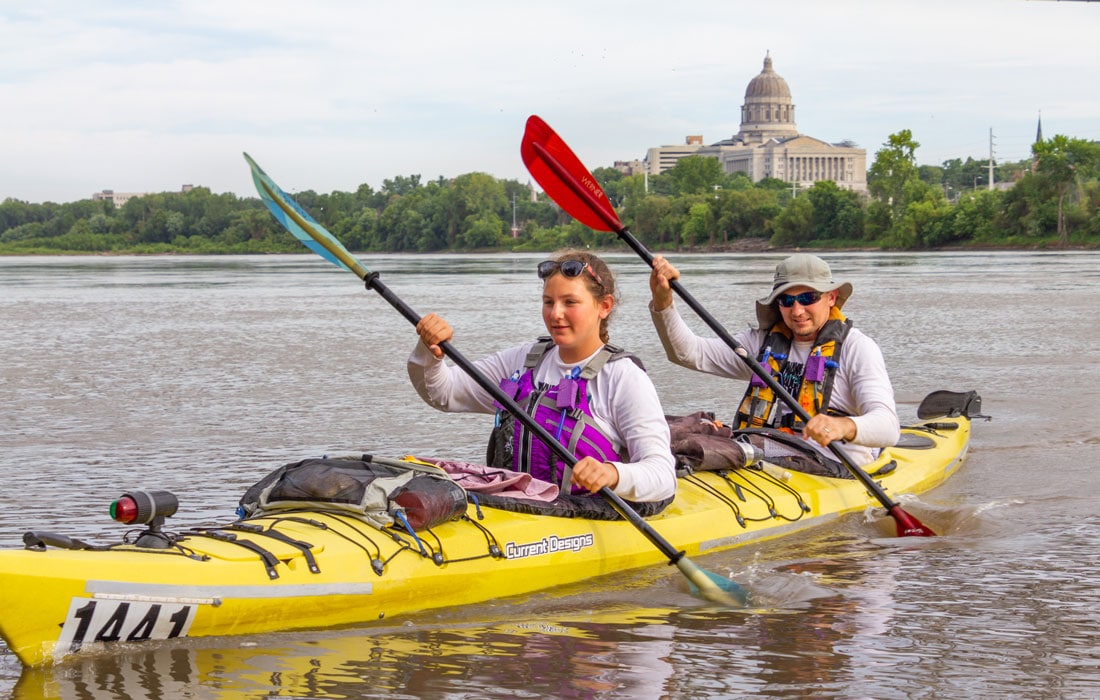
In 2017, when I was racing solo, I was below Hermann when a barge came up out of nowhere. I hid along a bank, and I saw as it was about to hit a whole swath of people; the captain had to come to a complete stop. Another year, a barge ran over a tandem couple and my husband saw it all happen. Somehow, thank God, they were fine and were able to claw their way up from under the barge.
Bob Hines:
Anything can happen during the race: heat exhaustion, stomach issues, getting hit by an Asian carp that dislocates your shoulder (all of which happened to me in 2016). Most years have an event that everybody remembers. For 2018, it was The Barge. There was a heavy barge pushing upstream that was creating a huge wake. Most boats pulled over and out of the water. I asked Cecelia what she wanted to do, pull over or go on? “Let’s do it!” was her response so we took an “aggressive” line past the barge. The wake hit us hard and we went airborne five times. We went full Lieutenant Dan (from Forrest Gump) by whooping and hollering the whole time. Cecelia had a blast, and anytime anyone mentioned The Barge her response was, “We went airborne five times! It was AWESOME!”
Night on the Water
All alone in the night with deep dark waters below and no clear view of what’s before you, the stars emerge in their brilliance. How were your nights?
Christopher Luedke:
At night, the river is equal parts terrifying and calming. There is a tranquil beauty punctuated by the occasional wing dike, buoy, or carp slapping the side of the boat. The biggest problem toward morning is staying awake and hallucinations later in the race.
Bob Hines:
Cecelia and I are big space nerds. She wants to be an astronaut. On the first night, as we were paddling from Miami to Glasgow, I spotted the International Space Station flying overhead. We both put down our paddles and sat quietly in awe as we just floated.
Support Teams
You can’t do it alone, as it is against the rules to not have support along the way. What is your team dynamic?
Diane McHenry:
My husband and my dad are my support. My dad’s 82, and it’s getting harder and harder for him to help me out. But he is still there, always with a smile and something quick to say. Thanks, Dad!

Mandy Urban:
When we pulled into Hermann, my family was there, including my dad, who surprised me last minute by being able to come. It gave me the boost of love and support I didn’t know I needed to finish the race well. I couldn’t have done this without the help of my mom! She loved me through the highs, the lows, the Frank Sinatra heat strokes, and mental breakdowns.
Chuck McHenry (crew member for Di McHenry and Mandy Urban):
I’ve raced white water all my life. I’ve made the Olympic team trials and raced World Cup events, so for me it’s very hard to stand on the sidelines and watch the amazing conditions that we had in 2018. But at the same time, there’s something about being support that is so fun. In Missouri, everybody wants to help everybody else; we don’t hesitate to help each other at any point. You see that in Missouri. We’ve raced other places, and they aren’t like that. In Texas, there’s a race with a shortcut and they won’t tell you where it is. I’ve raced out East, and we were told to go home because we were from Missouri. Missouri is a really good place to be.
The Secret
With more than 500 separate vessels racing, everyone creates little tips and tricks for themselves. What’s yours?
Diane McHenry:
I really like the insulated water containers with tubes to drink from because the ice jug can hold and keep the water very cold. My kayak is light, stable, and fast. That’s what you want in a good kayak. It’s stable for when you get too tired so you can relax a little bit and go with the flow. You’re the motor on the boat, so if you’ve trained properly that makes the most difference. If you’re not trained, it doesn’t matter what boat you have.
John VanderHeyden:
The boat I use was originally a 1950s-era 17-foot sailboat that I’ve converted to be pedal powered. The modifications to the boat include: complete solar charging system, an electric bilge pump, battery, lights/USB hook ups for phones, and other features. The bicycle-to-paddle-wheel configuration is my own design. I used a mountain bike and reworked and cut/welded it myself. The paddle wheels are bicycle wheels attached with a long axle to each side of the boat. The wheels consist of 16 paddles per side. I spent several years working in bicycle repair shops, so this is up my alley. My friend/paddle partner Tom Reed put his creativity to use by painting a serpent the length of boat.
Small-Town Hospitality
It takes hundreds of volunteers from small river towns to run the MR340. What impressed you?
Anqi Dai:
The volunteers at each boat ramp are so incredible. They help you out of your boat, and carry it out of the water, which is a big deal when you are exhausted. They feed and give you water and give you encouragement to go on. They are the unsung heroes of the race. We couldn’t do the race without their support and kindness.
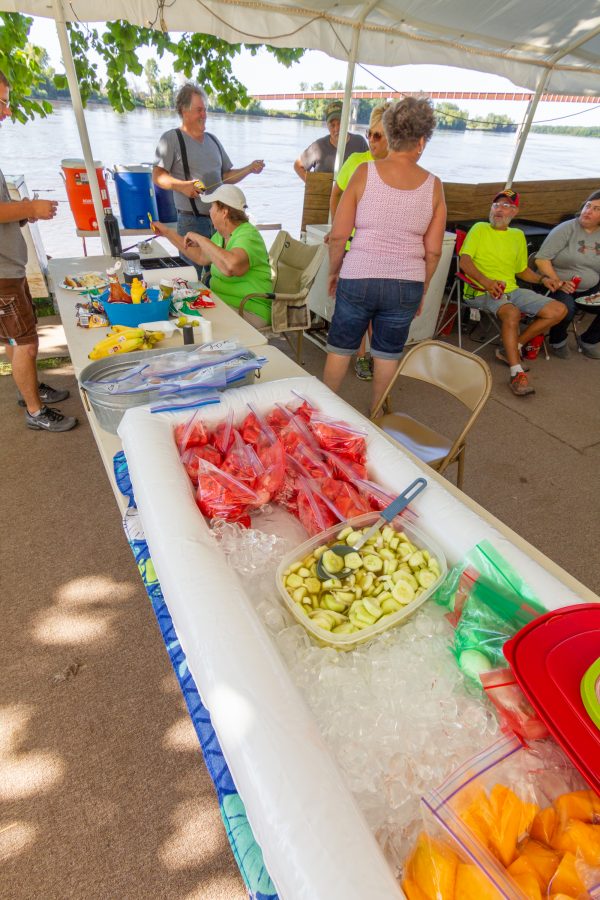
Diane McHenry:
The race could not happen without the volunteers. It’s grown every year and it’s amazing that they come out and become part of the culture. They love helping and they make it a good experience for everyone. And they get a little fundraising for their towns at the same time, so it’s great for them too. We actually went back a few times to visit the river towns because we wanted to actually see and explore them for once.
Hallucinations
If you’re trying to be competitive and finish with a good time, you’re going to have to skip sleeping. This frequently causes hallucinations. What did you see?
Christopher Luedke:
You might see mermaids or tree people. It’ll happen to most people on the second or third night. It’s a mix of sleep deprivation and the continuous physical effort being put forth, so your brain is trying desperately to shut down. It’s messing with your reality to try to force you to stop. I like to focus on things that I know are real, like the feel of the paddle in my hands. This technique is called grounding and can help a lot.

Mandy Urban:
Last year, as I did in my first year, I saw elephants—endless elephants—mile after mile marching along the banks of the river. I’ve also seen all types of faces and cartoon characters. I was happy when we got to paddle alongside a dad and his teenage son. It was great to talk with him and laugh about the hallucinations we were experiencing and make it into something fun instead of something scary.
John VanderHeyden:
One year, my rowing partner and I somehow got off the river and into a slough somewhere near Jefferson City. We could not figure out how to get back into the channel. We could see lights from other boats but they were through some trees. They looked like robots leaving us behind. We were both seeing giant trees and vegetation that looked like they were being grown and harvested to sell. We used up a lot of energy that night, and Tom messed up his back while trying to get us out of there. We had to call a safety boat at 2 in the morning to help guide us out. We finally escaped but lost around five or six hours.
Talking Teammates
You and your teammate are in the boat together for a long time. How do you work together as a team?
Mandy Urban:
Di has patience, age, and grace. I have so much to learn from her that there is a level of respect that adds to our dynamic. We are just a couple of river gals who like to race and have a good time. You can hear us singing or laughing way before you see us. We have a positive energy that works well in tough situations. She lifts me up when I’m down, usually in the beginning of the race, and I lift her up when she is struggling, usually toward the end. I love racing with Di; she is my river mom.
Bob Hines:
The toughest part is also the best part: I am racing with my daughter. Going tandem with another adult is challenging but when it’s your child, it adds another layer of pressure and concern. My wife as my ground crew usually knows what to expect, but last year we were both clueless about how our daughter would react to a three-plus day race. She is strong and determined but would she try to push herself too far? Through it all, the opportunity to have real, in-depth conversations with my teenage daughter was the best part of all. For good and bad, I’m pretty sure we talked more about pooping during the race than in the entire history of fathers and teenage daughters before us. After this race and all the time with Cecelia, going solo again in the future seems like a bit of a waste as it’s just a bunch of paddling and no bonding.
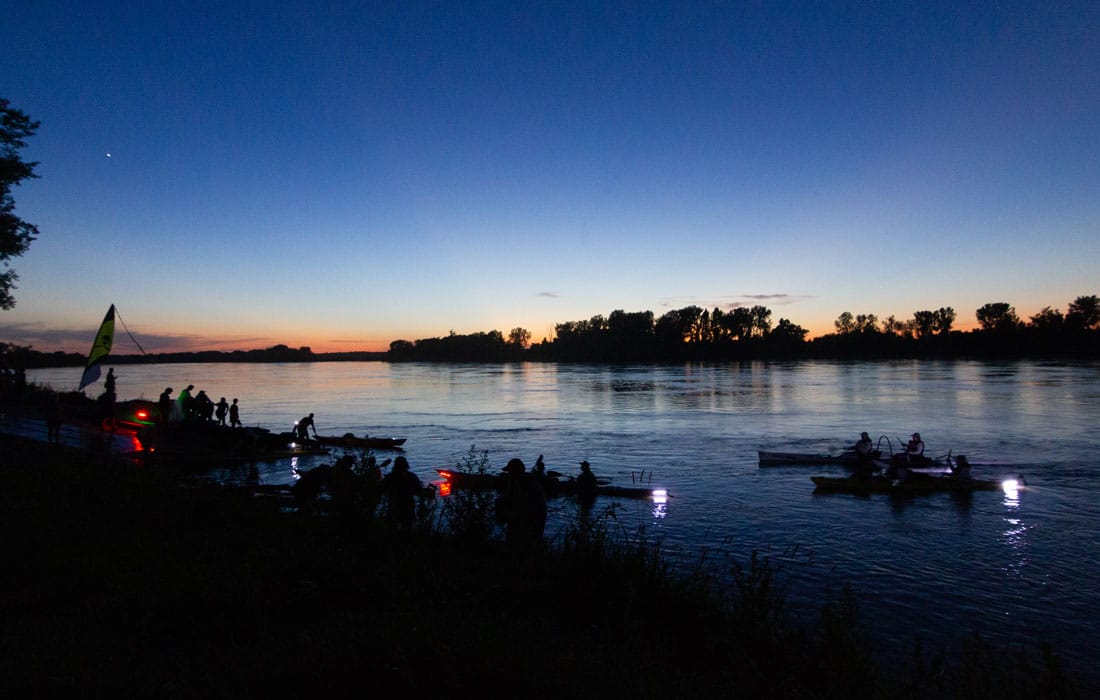
The Pain
Anyone in endurance sports will tell you there comes a time when you hit a wall. What do you do?
Mandy Urban:
I hit my low point about halfway through the race, maybe mile 186. We had stopped at Franklin Island. The sun was coming up, and I was letting the feelings from the previous night pass. I had to sleep with no pants on because my tailbone had been rubbed raw by my seat. After 30 minutes, ground crew woke us up. Di bandaged me up, and we headed back to the boat. I was shivering hard, and I remember crying and not wanting anyone to see. I put my sunglasses on and faked a smile. I realized that with the completion of this race, I would have participated in an accumulated 800 race miles of racing in the 2018 season. I felt the odds stacked against me, and it all felt like too much to handle. Di let me cry. Then it hit me that I am the only one to determine how much grit is left on my sandpaper. I get to decide if this is too much. It was the turning point for me, and I found a deep-seated strength and used it to power us along the second half of the race.
Bob Hines:
Cecelia was tired coming into New Haven around 3:30 am so I let her sleep in the boat while I paddled. I paddled in the darkness for more than an hour, and when dawn came, I saw that her paddle was missing from its clip. I woke Cecelia up and explained the situation, and she started to cry. It was her special paddle that she had picked out so she could do the race. It had a cool design on it, and now it was lost. I don’t blame her for crying at all. I gave her my phone to call ground crew. “Your phone’s dead,” she said back to me. “It can’t be. It was at 15 percent when I shut it down earlier,” I replied. Fortunately, I remembered that our new tracker had satellite texting! So Cecelia texted ground crew, and they got ready to meet us. My wife, Emily, had gone around asking if anyone had an extra paddle, and she found one.
Final Stretch
After days of paddling, you finally came within striking distance of St. Charles and the finish line. What is it like, knowing you’re close?
Bob Hines:
After shoving off from our emergency stop, I didn’t even recognize the part of the river we were on, and that flustered me because we trained on this stretch of the river and I could describe all of the crossings from there to St. Charles with my eyes closed. Once we paddled back up with the channel and rounded the bend, it hit me: we were near the Klondike boat ramp and had less than a “Klondike” run (24 miles) to the finish line. We paddle this part of the river so often that “Klondikes” are units of measurement for me. With that realization, I started crying—ugly crying. I tried to hide it from Cecelia, but she turned around to check if I was okay because I wasn’t able to keep paddling. I was so proud of Cecelia.
Finish Line
Now that it’s over, how do you feel?
Diane McHenry:
I wasn’t expecting to finish so well [first place in the 2018 women’s tandem division]. Especially at my age, I just want to finish well. My only goal is to do my best, so this was just a big bonus. Our ground crew was awesome. It was a good year for us.
Mandy Urban:
This finish was different from others in that I had never imagined that I would finish the race in less than 50 hours, much less 45. After arriving on land, there was excitement, joy, and then the beloved “hand me a beer” moment. Just getting to the end is one of the greatest feelings.
Bob Hines:
Arriving at the end, I was physically exhausted. We entered into third place by keeping our Hermann stop quick while another boat that arrived before us was sleeping. I knew they were great paddlers, and we didn’t know how much of a jump we got on them. So there was zero let-up for those last 70 miles, especially when 24 of those miles I was paddling alone. At the dock, I was ready to get out of the boat, but at the same time, I knew that once I got out of the boat, this whole experience and spending so much time with Cecelia would be over. I took a few moments to myself before climbing out.
Missouri Life’s MR340 Roster
Here’s how the competitors who shared their experience with us finished in the 2018 MR340.
TEAMS
2nd Year “B” Itch
Diane McHenry, Mandy Urban
Hometowns: Ironton, Springfield
Division: Women’s Tandem
Finish: 1st in division, 23rd overall
Time: 45:11
Dynamic Dad Daughter Duo
Bob Hines, Cecelia Hines
Hometown: St. Charles
Division: Mixed Tandem
Finish: 3rd in division, 61st overall
Time: 50:51
VanReed
John VanderHeyden, Thomas Reed
Hometowns: Catawissa, Webster Groves
Division: Pedal/Stand-Up Paddleboard Tandem
Finish: 2nd in division, 107th overall
Time: 57:02
SOLO COMPETITORS
Christopher Luedke
Hometown: Nashotah, Wisconsin
Division: Men’s Solo
Finish: 6th in division, 11th overall
Time: 42:21
Anqi Dai
Hometown: Parkville
Division: Men’s Solo
Finish: 140th in division, 355th overall
Time: 80:39
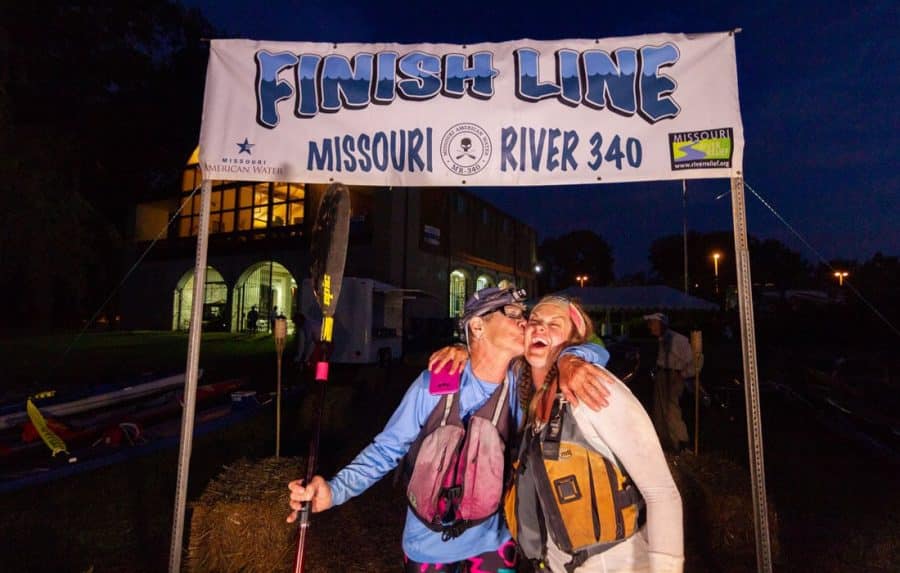
Related Posts
Inside Walt Disney’s Life in Marceline
Very little remains of the once massive cottonwood tree Walter Elias Disney called his “Dreaming Tree.” The coarse, woody debris is an anchor tying a small town in Missouri to the pioneer of the American entertainment industry.
Inside Jefferson City’s Museum of Modern Art
Opened in October 2015, the Jefferson City Museum of Modern Art features the works of Purvis Young, Thornton Dial, and Abdoulaye Diarrassouba, better known as Aboudia. All have earned national and international acclaim for their art, which can be found in some of the country’s most distinguished museums.
Inside the Newest Cafe & Bike Shop on the Katy Trail
Closely nuzzled against the Katy Trail in Rocheport, Meriwether Café & Bike Shop provides a quietly colorful experience. Managers Brandon and Whitney Vair transformed the building that used to house the Trailside Café into a bright spot set against the green-covered hills of Rocheport.

